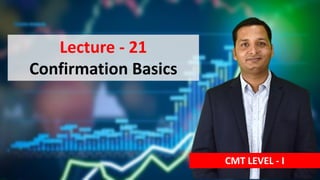
Section 2 - Chapter 13 Part I - Confirmation Basics
- 1. Lecture - 21 Confirmation Basics CMT LEVEL - I
- 2. CMT LEVEL - I Learning Objectives Price Confirmation Indexes and Oscillators Analysis Methods - Overbought & Over Sold - Failure Swings - Divergences - Reversals - Trend ID - Crossovers - Classic Patterns
- 3. Confirmation Basics Overbought & Over Sold Failure Swings Divergences Reversals Crossovers Trend ID Classic Patterns
- 4. Overbought & Over Sold • Bound momentum indicators are best suited for overbought/oversold analysis. • Bound oscillators, such as RSI and the Stochastic Oscillator, fluctuate within a specific range, zero to one hundred in this case. • Overbought means an extended price move to the upside; oversold to the downside • When price reaches these extreme levels, a reversal is possible. • Overbought describes a period of time where there has been a significant and consistent upward move in price over a period of time without much pullback. • Oversold describes a period of time where there has been a significant and consistent downward move in price over a period of time without much pullback.
- 5. Failure Swings • A Failure Swing is a specific type of breakout from an overbought or Oversold zone first described by wilder in 1978 • A Negative failure swing occurs when the oscillators breaks down out of an overbought zone creates a reversal point , pullbacks but fails to re enter the zone , and then breaks back down below the earlier reversal point . • A positive Failure swing is the opposite at an oversold zone.
- 6. Divergences • Divergence is when the price of an asset is moving in the opposite direction of a technical indicator, such as an oscillator, or is moving contrary to other data. •Divergence warns that the current price trend may be weakening, and in some cases may lead to the price changing direction. •There is positive and negative divergence. Positive divergence indicates a move higher in the price of the asset is possible. Negative divergence signals that a move lower in the asset is possible.
- 7. Reversals • A reversal shows that the price direction of an asset has changed, from going up to going down, or from going down to going up. •Traders try to get out of positions that are aligned with the trend prior to a reversal, or they will get out once they see the reversal underway.
- 8. Reversals •Reversals typically refer to large price changes, where the trend changes direction. Small counter-moves against the trend are called pullbacks or consolidations. •When it starts to occur, a reversal isn't distinguishable from a pullback. A reversal keeps going and forms a new trend, while a pullback ends and then the price starts moving back in the trending direction.
- 9. Trend ID •In a trending Markets oscillators will remain in one half of their range for long period and breakout signal from standard overbought and oversold zone are often false . • According to strong Trending markets we can adjust overbought or oversold zones to reduce false breakout like 70 level increase to 90 for overbought in RSI for Up trending Markets or vice versa. • This adjustment of zones not have any impact on divergence or reversals
- 10. Crossovers •The crossover is a point on the trading chart in which a security and an indicator intersect. It is used to estimate the performance of a financial instrument and to predict coming changes. •Crossovers indicating a moving average are generally the cause of breakouts and breakdowns. Moving averages can determine a change in the price trend based on the crossover. •A crossover is used by a technical analyst to forecast how a stock will perform in the near future.
- 11. Classic Patterns •Oscillators & Indicators are also make simple patterns such as triangle , rectangle and produce support & resistance levels just price does. • They even have trends that can be defined by a classic trend line . • These patterns have same validity as price patterns , even when the oscillators are bounded.
